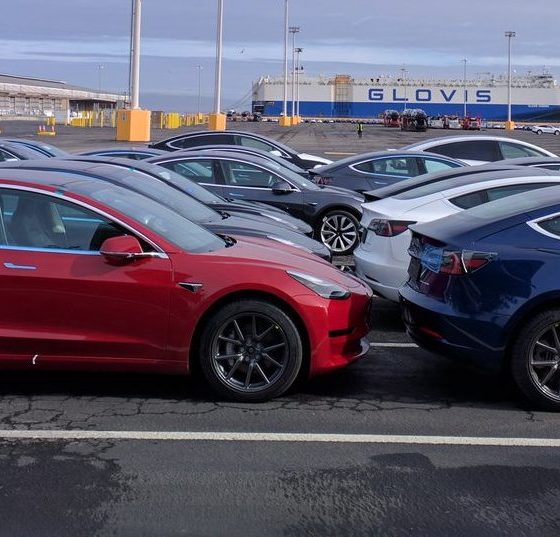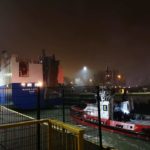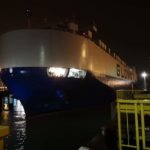

News
Tesla Model 3 invasion in Europe becomes imminent as cargo ship arrives in Belgium
After conquering the United States’s luxury car market in 2018, the Tesla Model 3 is now heading to foreign territories. In Elon Musk’s letter to employees last month, the CEO noted that the Model 3’s push in Europe and China this first quarter would be critical to the company’s profitability, particularly since deliveries in these territories would start with higher-priced variants like the Long Range AWD and the Performance variant. Amidst the anticipation of the Model 3’s worldwide distribution, reports have now emerged indicating that the first large batch of electric sedans has safely arrived at the port of Zeebrugge in Belgium.
Tesla has not shared details of the first Model 3 shipment that recently arrived in European shores. That said, reports from local media outlets back in December noted that Tesla would be shipping around 3,000 Model 3 to the Zeebrugge port every week. Reports also pointed out that the electric sedans would be shipped quickly, with the vehicles being loaded on RoRo (roll-on, roll-off) ships to facilitate quick loading and unloading. As another way to optimize the deliveries of Model 3 to the region, the transportation of the cars from the United States to Zeebrugge will reportedly take only about 15 days, considering that the cargo ships carrying the vehicles would be passing through the Panama Canal.
The first of these Model 3-filled cargo ships — the Glovis Captain — has been tracked religiously by the Tesla community from its departure in the United States to its arrival at the Belgian port. As noted by a number of dedicated Tesla enthusiasts who have been tracking the ship’s whereabouts, Glovis Captain has recently docked at Zeebrugge. With this, it would likely be just a matter of time before Tesla starts delivering the Model 3 to the first batch of reservation holders in the region. Following are pictures of the cargo ship in the Belgian port as shared by members of the Tesla community.
- (Photo: Ulric Dabe/Twitter)
- (Photo: Ulric Dabe/Twitter)
- (Photo: Ulric Dabe/Twitter)
- (Photo: Ulric Dabe/Twitter)
- (Photo: Kristof Lambrecht/Twitter)
The Glovis Captain arrives at the port of Zeebrugge. (Photos: Ulric Dabe and Kristof Lambrecht/Twitter)
With the arrival of the Model 3 in Europe, the disruption of the auto industry that the vehicle started in the United States could very well extend to the European region. In 2018, the Model 3 all but shook the US auto market, becoming such a force that it started closing in on mainstream passenger sedans like the Honda Accord and the Toyota Camry. By the end of 2018, the Model 3 was also hailed as a best-selling car in the US’ luxury auto market, selling more than 145,000 units during the year. It should be noted that the Model 3 accomplished these feats in the US despite Tesla’s production issues with the vehicle.
In a way, the true potential of the Model 3 might actually be seen in the vehicle’s performance in the European market, considering that passenger cars are an active, lucrative segment in the region. Compared to the United States, which largely favors SUVs and pickup trucks, Europe is far friendlier to sedans. In the company’s Q3 2018 Update Letter, Tesla noted that the mid-sized premium sedan market in Europe is “more than twice as big as the same segment in the US. In the recently released Q4 2018 letter, the company reiterated this point, stating that “the market opportunity for Model 3 in Europe and China exceeds North America based on the most recent sales of mid-sized premium sedans.”
Over the past months, the pieces have fallen in place for the Model 3’s European invasion. In January, it was confirmed that the electric sedan had achieved homologation approval, paving the way for a seamless rollout of the vehicles in the region. Test drive programs for the Model 3 have also begun in select European areas, giving reservation holders and potential customers a taste of what the electric sedan has to offer.

Elon Musk
Delaware Supreme Court reinstates Elon Musk’s 2018 Tesla CEO pay package
The unanimous decision criticized the prior total rescission as “improper and inequitable,” arguing that it left Musk uncompensated for six years of transformative leadership at Tesla.

The Delaware Supreme Court has overturned a lower court ruling, reinstating Elon Musk’s 2018 compensation package originally valued at $56 billion but now worth approximately $139 billion due to Tesla’s soaring stock price.
The unanimous decision criticized the prior total rescission as “improper and inequitable,” arguing that it left Musk uncompensated for six years of transformative leadership at Tesla. Musk quickly celebrated the outcome on X, stating that he felt “vindicated.” He also shared his gratitude to TSLA shareholders.
Delaware Supreme Court makes a decision
In a 49-page ruling Friday, the Delaware Supreme Court reversed Chancellor Kathaleen McCormick’s 2024 decision that voided the 2018 package over alleged board conflicts and inadequate shareholder disclosures. The high court acknowledged varying views on liability but agreed rescission was excessive, stating it “leaves Musk uncompensated for his time and efforts over a period of six years.”
The 2018 plan granted Musk options on about 304 million shares upon hitting aggressive milestones, all of which were achieved ahead of time. Shareholders overwhelmingly approved it initially in 2018 and ratified it once again in 2024 after the Delaware lower court struck it down. The case against Musk’s 2018 pay package was filed by plaintiff Richard Tornetta, who held just nine shares when the compensation plan was approved.
A hard-fought victory
As noted in a Reuters report, Tesla’s win avoids a potential $26 billion earnings hit from replacing the award at current prices. Tesla, now Texas-incorporated, had hedged with interim plans, including a November 2025 shareholder-approved package potentially worth $878 billion tied to Robotaxi and Optimus goals and other extremely aggressive operational milestones.
The saga surrounding Elon Musk’s 2018 pay package ultimately damaged Delaware’s corporate appeal, prompting a number of high-profile firms, such as Dropbox, Roblox, Trade Desk, and Coinbase, to follow Tesla’s exodus out of the state. What added more fuel to the issue was the fact that Tornetta’s legal team, following the lower court’s 2024 decision, demanded a fee request of more than $5.1 billion worth of TSLA stock, which was equal to an hourly rate of over $200,000.
Delaware Supreme Court Elon Musk 2018 Pay Package by Simon Alvarez
News
Tesla Cybercab tests are going on overdrive with production-ready units
Tesla is ramping its real-world tests of the Cybercab, with multiple sightings of the vehicle being reported across social media this week.

Tesla is ramping its real-world tests of the Cybercab, with multiple sightings of the autonomous two-seater being reported across social media this week. Based on videos of the vehicle that have been shared online, it appears that Cybercab tests are underway across multiple states.
Recent Cybercab sightings
Reports of Cybercab tests have ramped this week, with a vehicle that looked like a production-ready prototype being spotted at Apple’s Visitor Center in California. The vehicle in this sighting was interesting as it was equipped with a steering wheel. The vehicle also featured some changes to the design of its brake lights.
The Cybercab was also filmed testing at the Fremont factory’s test track, which also seemed to involve a vehicle that looked production-ready. This also seemed to be the case for a Cybercab that was spotted in Austin, Texas, which happened to be undergoing real-world tests. Overall, these sightings suggest that Cybercab testing is fully underway, and the vehicle is really moving towards production.
Production design all but finalized?
Recently, a near-production-ready Cybercab was showcased at Tesla’s Santana Row showroom in San Jose. The vehicle was equipped with frameless windows, dual windshield wipers, powered butterfly door struts, an extended front splitter, an updated lightbar, new wheel covers, and a license plate bracket. Interior updates include redesigned dash/door panels, refined seats with center cupholders, updated carpet, and what appeared to be improved legroom.
There seems to be a pretty good chance that the Cybercab’s design has been all but finalized, at least considering Elon Musk’s comments at the 2025 Annual Shareholder Meeting. During the event, Musk confirmed that the vehicle will enter production around April 2026, and its production targets will be quite ambitious.
News
Tesla gets a win in Sweden as union withdraws potentially “illegal” blockade
As per recent reports, the Vision union’s planned anti-Tesla action might have been illegal.

Swedish union Vision has withdrawn its sympathy blockade against Tesla’s planned service center and showroom in Kalmar. As per recent reports, the Vision union’s planned anti-Tesla action might have been illegal.
Vision’s decision to pull the blockade
Vision announced the blockade in early December, stating that it was targeting the administrative handling of Tesla’s facility permits in Kalmar municipality. The sympathy measure was expected to start Monday, but was formally withdrawn via documents sent to the Mediation Institute and Kalmar Municipality last week.
As noted in a Daggers Arbete report, plans for the strike were ultimately pulled after employer group SKR highlighted potential illegality under the Public Employment Act. Vision stressed its continued backing for the Swedish labor model, though Deputy negotiation manager Oskar Pettersson explained that the Vision union and IF Metall made the decision to cancel the planned strike together.
“We will not continue to challenge the regulations,” Petterson said. “The objection was of a technical nature. We made the assessment together with IF Metall that we were not in a position to challenge the legal assessment of whether we could take this particular action against Tesla. Therefore, we chose to revoke the notice itself.”
The SKR’s warning
Petterson also stated that SKR’s technical objection to the Vision union’s planned anti-Tesla strike framed the protest as an unauthorized act. “It was a legal assessment of the situation. Both for us and for IF Metall, it is important to be clear that we stand for the Swedish model. But we should not continue to challenge the regulations and risk getting judgments that lead nowhere in the application of the regulations,” he said.
Vision ultimately canceled its planned blockade against Tesla on December 9. With Vision’s withdrawal, few obstacles remain for Tesla’s long-planned Kalmar site. A foreign electrical firm completed work this fall, and Tesla’s Careers page currently lists a full-time service manager position based there, signaling an imminent opening.













